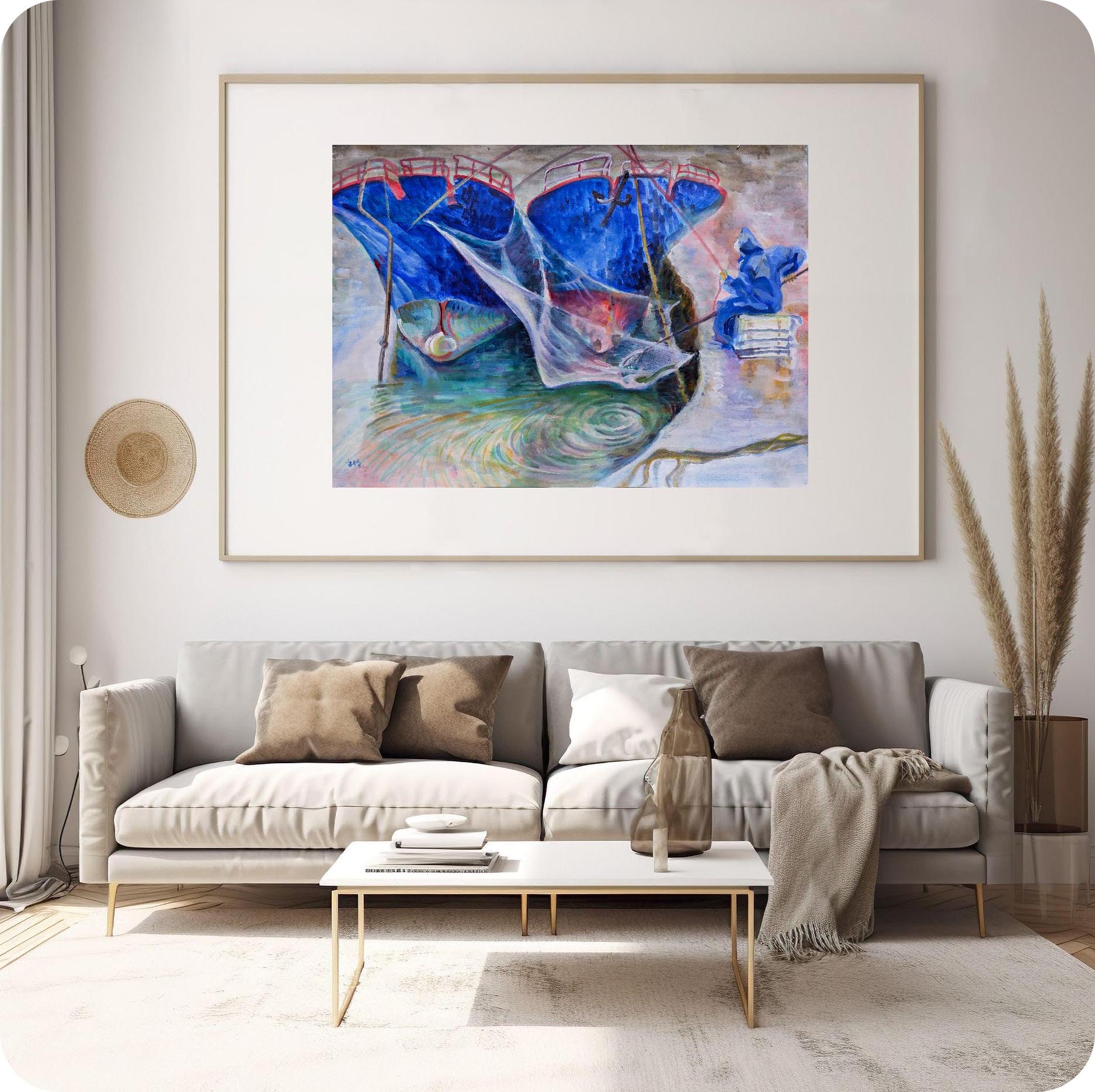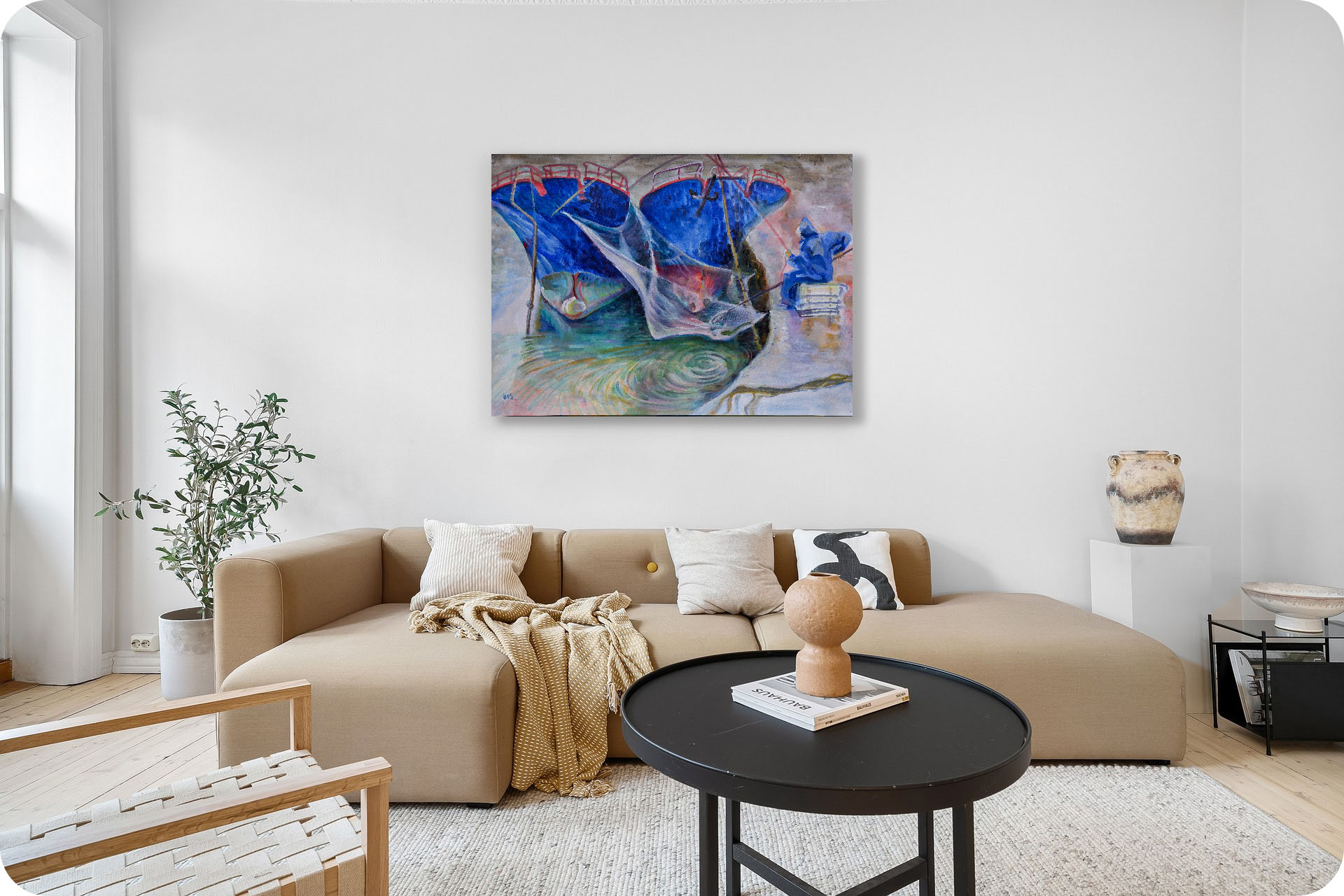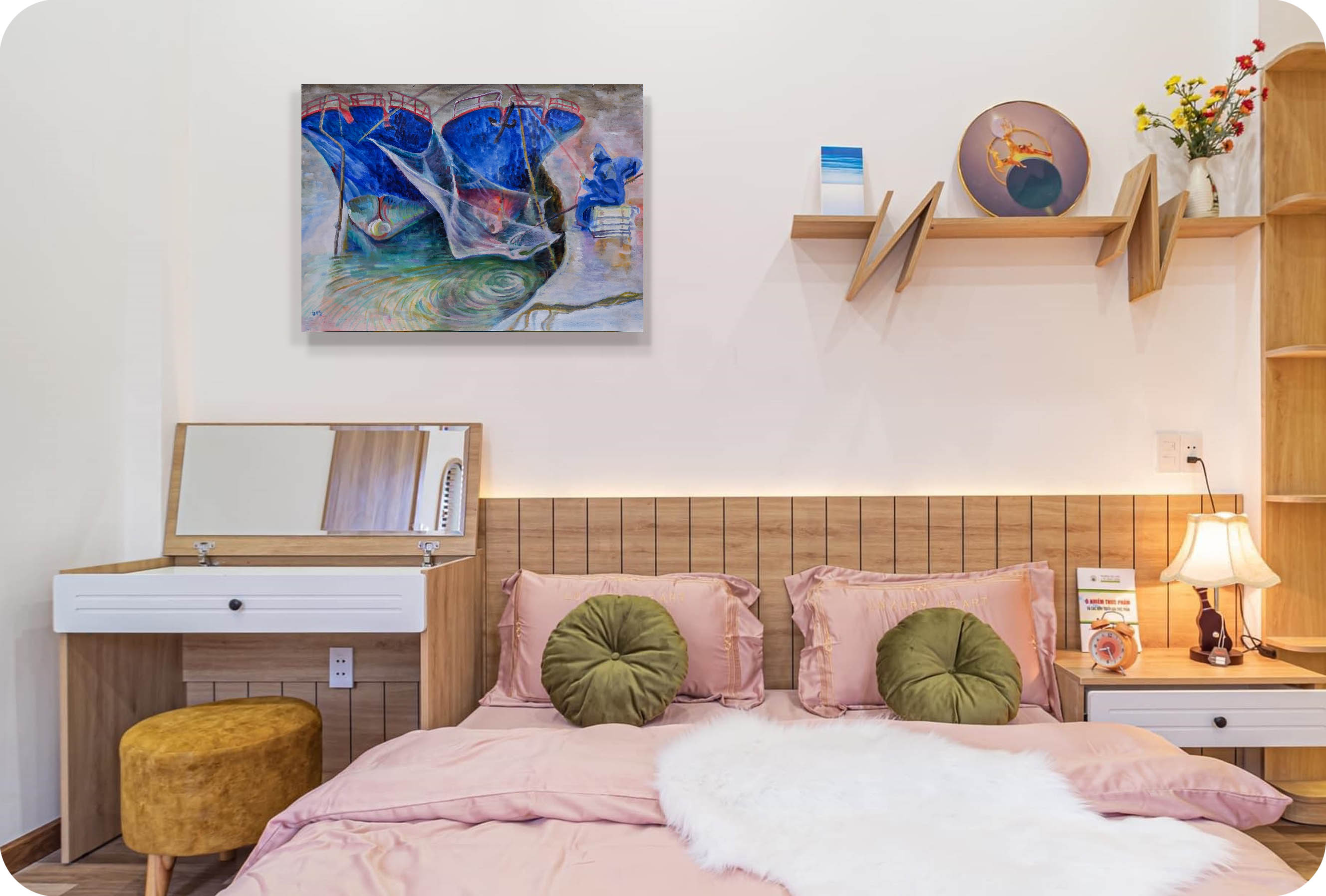This painting was created in 2024. The colors of this year are still bright but not dazzling. I have gradually found a balance point among the bright colors.
This is a scene of fishing on a rainy day. I don't know if this method of fishing is popular elsewhere, but it's ancient and efficient. It is huge and slow, so slow that it seems that every time the net is raised, it lifts up the past time of the entire harbor, just by the strength of the fisherman alone.
Inches: x in
Size without the frame: x cm
Country: China
Date: 2024
Materials: Watercolor Acrylic paint on paper.
Condition: well preserved
Creative themes and style | My works revolve around the creative concept of "The land of humanity, People on the land".The people in the painting are people in nature, and the lines, shapes, and colors are close to nature. The nature in the painting is nature in the eyes of humans, existing in interaction with humans.I don’t pursue a series of works with a fixed and continuous style. I hope that the style of the pictures will synchronize with the changes in my life and always remain oscillating. The performance of the work must be in sync with the development of one's own life in order to be Sincere and powerful.Ideas are later.
An Interview with Artist Philo by Artphiloso Gallery
If you would like to collect this artwork or know more about the artist, please contact us.
art for the office,artwork for office walls,office art work,art home office,office wall picture.



1. Medium and Technique
This painting translates the daily rhythm of the fishing port into a poetic scene through the fluidity of watercolor. The artist employs the color sensitivity of Impressionism, allowing washes of blue, green, and violet to blur boundaries between ships, nets, and water. The use of the wet-on-wet technique infuses the fishing net with transparency, creating a shifting balance between reality and illusion.
2. The Hulls and Ocean Memory
The massive blue hulls dominate the composition like silent witnesses of the sea. Their tilted forms break the rigidity of geometric outlines, suggesting both the weight of maritime labor and the unpredictable vitality of the ocean. Rather than being confined by straight lines, the ships spill beyond their edges, symbolizing the overflow of emotion and memory carried by the sea.
3. The Fishing Net as Metaphor
The net, stretching across the canvas, is not rendered with precision but with blurred transparency. This deliberate vagueness resists the logic of “accurate capture” and instead emphasizes ambiguity. The barely discernible fish inside transform the act of fishing into a game of concealment and revelation. The net becomes a metaphor for labor itself: both a means of survival and a fragile veil between humans and the ocean’s hidden power.
4. The Fisherman and De-Personalization
The fisherman in blue, reduced to a simplified silhouette, merges chromatically with the environment. This color echo strips the figure of individuality, transforming him from a personal subject into a symbol of collective labor. The question emerges: is it the fisherman who lifts the net, or is it the ocean itself performing a ritual of giving and taking through human hands?
5. Dynamics of Motion and Balance
Ripples in the water, the tension of the net, and the tilted ships together construct a dynamic equilibrium. Though the literal act of “lifting the net” is not depicted, its presence is implied through rhythm, color, and gesture. The scene hovers between stillness and movement, mirroring the precarious balance of human survival at sea.
6. Conceptual Dimension
This painting subverts the warm, idealized image of portside labor. Instead of a straightforward narrative of harvest, it presents a rebellious reinterpretation: labor is chaotic, uncertain, even absurd. Through the loss of control in color and the ambiguity of form, the artist destabilizes conventional readings and exposes fishing as a fragile negotiation between human persistence and the ocean’s indifference.
7. Summary
Ultimately, the work elevates a routine act into a profound allegory. “Lifting the net” ceases to be mere documentation of labor; it becomes a poetic confrontation with nature, a metaphor for the fragile game of survival, and an artistic rebellion against conventional realism. In this watercolor’s misty surface, viewers encounter not only the breath of the ocean but also the deeper question of humanity’s place within its vast, uncertain rhythms.
Marc Chagall, The Docks of Vitebsk – Dreamlike colors and romantic composition evoke a poetic vision of everyday life.
Paul Gauguin, Boats in Tahiti – Simplified forms and vivid tones capture the exotic vibrancy of maritime life.
Sanyu, Blue and White Porcelain Pot with Chrysanthemums – Minimal brushwork and subtle color fields convey tranquility and fragility.
John Singer Sargent, Barges in Venice – Fluid brushwork and nuanced light effects render the interplay of water, boats, and atmosphere.
The artist overlays warm and cool color layers, allowing the net to shimmer between blue and violet-pink, creating a light, translucent effect. Parts of the net carry an iridescent glow, reminiscent of soap-bubble color dispersion, making its presence both tangible and dreamlike.
The hull is not a flat block of color, but built up with cobalt blue, ultramarine, and violet. Accents of red along the boat’s edge heighten the warm–cool contrast, giving the blue mass a sense of depth and pressure, like a wall that generates visual tension and spatial progression.
The figure is shaped with broad blue tonal areas, its outline almost swallowed by the surrounding water. Yet the subtle detailing of the hands conveys tension. This sculptural rigidity contrasts with the flowing water and the supple net, enhancing the painting’s balance of strain and release.
Casting the Net belongs to contemporary maritime oil painting, not as a literal depiction of fishing but as an artistic image of labor and the sea. It appeals to collectors who value both color experimentation and social narrative depth—making it suitable for private studios as well as academic or thematic collections.
With its strong atmospheric narrative, the painting can create an immersive seaside presence within a gallery. Closely tied to harbor culture and memory, it evokes layered associations of labor, water, and history. This makes it a distinctive centerpiece for public exhibitions or private collections rooted in regional and cultural identity.
A: Click here to view ARTPHILOSO's Guide for Collectors.
